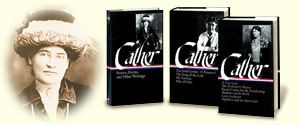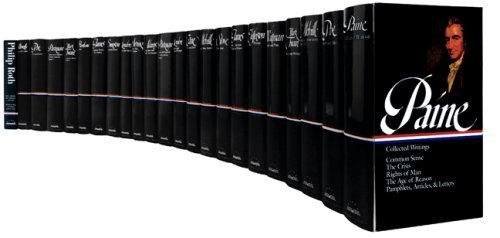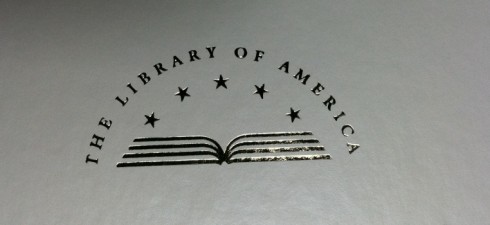I’m not afraid to admit it. I have a problem. I’m addicted to books. I thought I had kept it hidden for many years, but when my wife finally catches me looking at the most recent Library of America catalogue with lust in my eyes, she doesn’t seem surprised. “Yes,” I confess to her, “I want them all,” as I stem the tide of drool from my lips with a handy napkin. “I know,” she says, “it’s okay,” but I can tell it’s not.
 I think a lot about my addiction–I think I understand it, at least the way it has been explained to me. Designed in the hearts of conspiring, evil men in these, the last days, the catalogue showcases the ongoing, sinister efforts of the Library of America to induce book lust among US readership by publishing attractive, authoritative, yet inexpensive, texts of great American writing. Each luscious Library of America volume is compact and trim, with perfect measurements of 4 and 7/8″ by 7 and 7/8″ constituting the “golden section” considered by ancient Greeks to be the ideal proportion. My wife points out to me that real books don’t look like this without a lot of airbrushing and photoshopping and that Library of America should be held responsible for some of the book image issues suffered by other publishers. I hang my head with guilt as she exits my library.
I think a lot about my addiction–I think I understand it, at least the way it has been explained to me. Designed in the hearts of conspiring, evil men in these, the last days, the catalogue showcases the ongoing, sinister efforts of the Library of America to induce book lust among US readership by publishing attractive, authoritative, yet inexpensive, texts of great American writing. Each luscious Library of America volume is compact and trim, with perfect measurements of 4 and 7/8″ by 7 and 7/8″ constituting the “golden section” considered by ancient Greeks to be the ideal proportion. My wife points out to me that real books don’t look like this without a lot of airbrushing and photoshopping and that Library of America should be held responsible for some of the book image issues suffered by other publishers. I hang my head with guilt as she exits my library.
In my defense, I argue with myself that each Library of America book has a “girl-next-door” quality, unlike the publications of some of Library of America’s more glamorous competitors. Like, say, The Folio Society, for instance, with its unattainable, pretentious productions arrayed, more often that not, in sexy quarter-bound goatskin leather and buckram, exotic moiré silk insets on the inside front and back boards, those raised, hand-tooled gold decorated band implants on the spines, the text printed in Verdana type on Caxton Wove paper, gilded top edges and a luxurious ribbon marker. 
Resignedly I ask myself, can anyone withstand the charms of the Library of America books, especially given the ready availability of their images on the internet? I can’t. Who can blame me? Just look at them and tell me, honestly, if you can. Also, I point out, it’s really just soft-book-porn, not the hard-core stuff. Rarely are any of the books completely naked in the catalogues. Sometimes they are dressed in dust jackets, perhaps in a risqué pose or two with their slender, long and white pages spread apart behind the covers. Sometimes they are more coyly displayed inside a modest slipcase, but with the cleavage of their Smyth-sewn binding just visible from the spine pushed out teasingly toward the viewer.
;
 In the centerfold of the catalogue I look for a picture that I hope will show the acid-free paper in each book, paper that will never turn yellow or brittle. You can see how each volume is laid open easily on its spine, lying flat without crinkling or buckling, the binding boards flexible yet strong, making each book a sensuous pleasure to hold and view. And, on the creamy pages, the Galliard typeface is exceptionally easy on the eyes.
In the centerfold of the catalogue I look for a picture that I hope will show the acid-free paper in each book, paper that will never turn yellow or brittle. You can see how each volume is laid open easily on its spine, lying flat without crinkling or buckling, the binding boards flexible yet strong, making each book a sensuous pleasure to hold and view. And, on the creamy pages, the Galliard typeface is exceptionally easy on the eyes.
I pull out my Visa card, palms almost sweating, and I order the Flannery O’Connor volume from Amazon, fantasizing about her telling me the story “A Good Man is Hard to Find.”
All overly-extended analogies aside, what about the rest of you? Does anyone else have a similar yearning for not just knowledge, but also for the tangible forms its storage takes? Where does this desire come from? Possibly an early fixation on scriptures bound in leather with gilded edges? Is there a certain publisher’s product you love? First editions? Limited special collector’s editions? Or is it wrong to judge a book by its cover, binding, paper and font, independent of its textual contents? Perhaps some of you consider books mere knowledge receptacles, glad that Kindle and its cousins may someday replace bound volumes as a waste of resources and space?
;
;

You know you have a book addiction problem when you stop by a bookstore on the way home from work, hide the evidence under your jacket, and lie to your spouse about being late–saying you stopped off at a bar.
I did that once, except I claimed I was coming home late from church–got stalled in the foyer!
Can I just say, your descriptions of the books, Wow! Great writing. I suffer from similar bibliophilic tendencies. I have a soft spot in my heart for the Dalkey Archive (http://www.dalkeyarchive.com/). They publish out-of-print-should-be classics… I used to have very low standards for my books, buying mass market editions at $.50-$2.00, but it feels dirty. As my taste has evolved, mass market editions have become harder to come across. For Christmas, I always ask for books, and I’ve learned if I’m not specific in the edition I want, I will inevitably receive the cheapest available. Which is fine, I should be grateful, right? But it does bug me when I walk by my bookshelf and notice the cheap, glossy, pastel cover of Kate Chopin’s “The Awakening.” It’s hideous.
Great post, Ed.
Scott, thanks. I actually have several copies of some books that I really love. A paperback to travel with or take notes in. A Kindle version, just … because. A nice hardback that I know will always be there for me and give the work the dignity it deserves.
Ed, I totally relate to this kind of addiction or fetish. I’ve spent hours furtively caressing Library of America titles in bookstores, and ogling pictures and descriptions of books online. To date, I’ve only gone all the way with the six Philip Roth Library of America collections that adorn my shelves. But I’m polyamorous when it comes to book collections. I have a similar fetish for…
Modern Library collection: http://www.modernlibrary.com/
Everyman Library collection: http://www.randomhouse.com/knopf/classics/
And my fetishes extend beyond book collections. And a few weeks ago I was up at 2:00 am, unable to sleep, and surfing the Criterion Collection of movies online, and worried my wife would wake up and catch me inflagrante delicto. It sometimes takes extreme acts of self-control not to give into the urge to purchase every single title in one fell, orgiastic swoop.
http://www.criterion.com/
Oh, the Criterion Collection! I am similarly obsessed. And so easy to get lost on the fantastic website …
Matt and Heidi, I’m similarly infatuated with the Criterion Collection and the bad news for my wallet is that Barnes & Noble has a lot of them on sale … constantly. I’ve grabbed several Ingmar Bergman, Fritz Lang and even Alfred Hitchcock DVDs (his pre-US period) this last year.
Matt, while I Iike the comprehensive approach of the Modern Library, I have reservations–I have found some of their production values a bit … tawdry, at least some of their earlier editions, with their fake cloth strips in the bindings, pretending to be sewn but really glued, that kind of thing. And the Everyman collection is nice and rivals the Library of America collection, and even surpasses it with the multi-color buckram covers, but it doesn’t have the scholarly apparatus you find in LoA publications, and, well, their title is sexist–book porn should appeal to everyone, not just “everyman”.